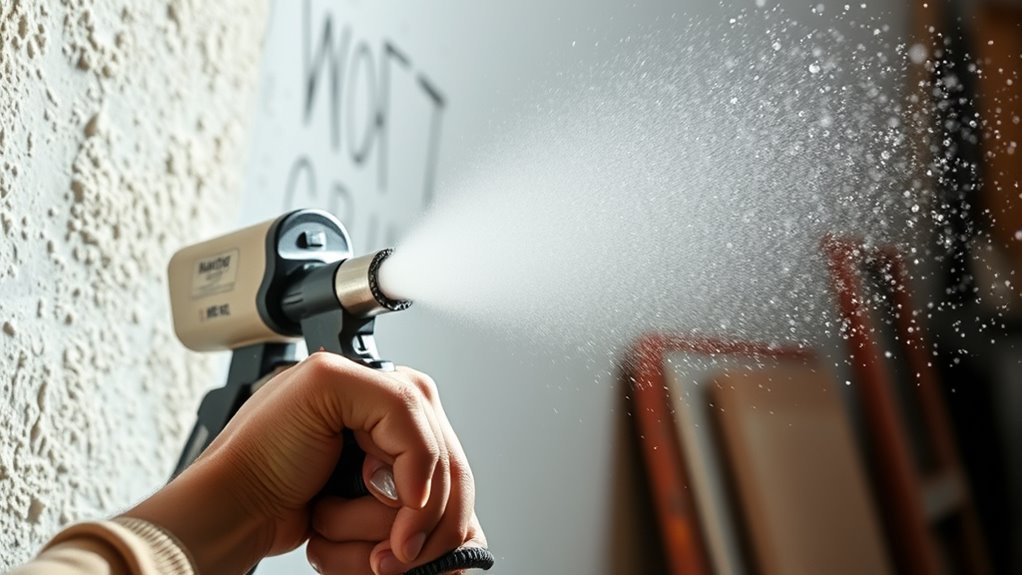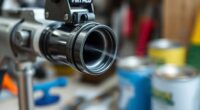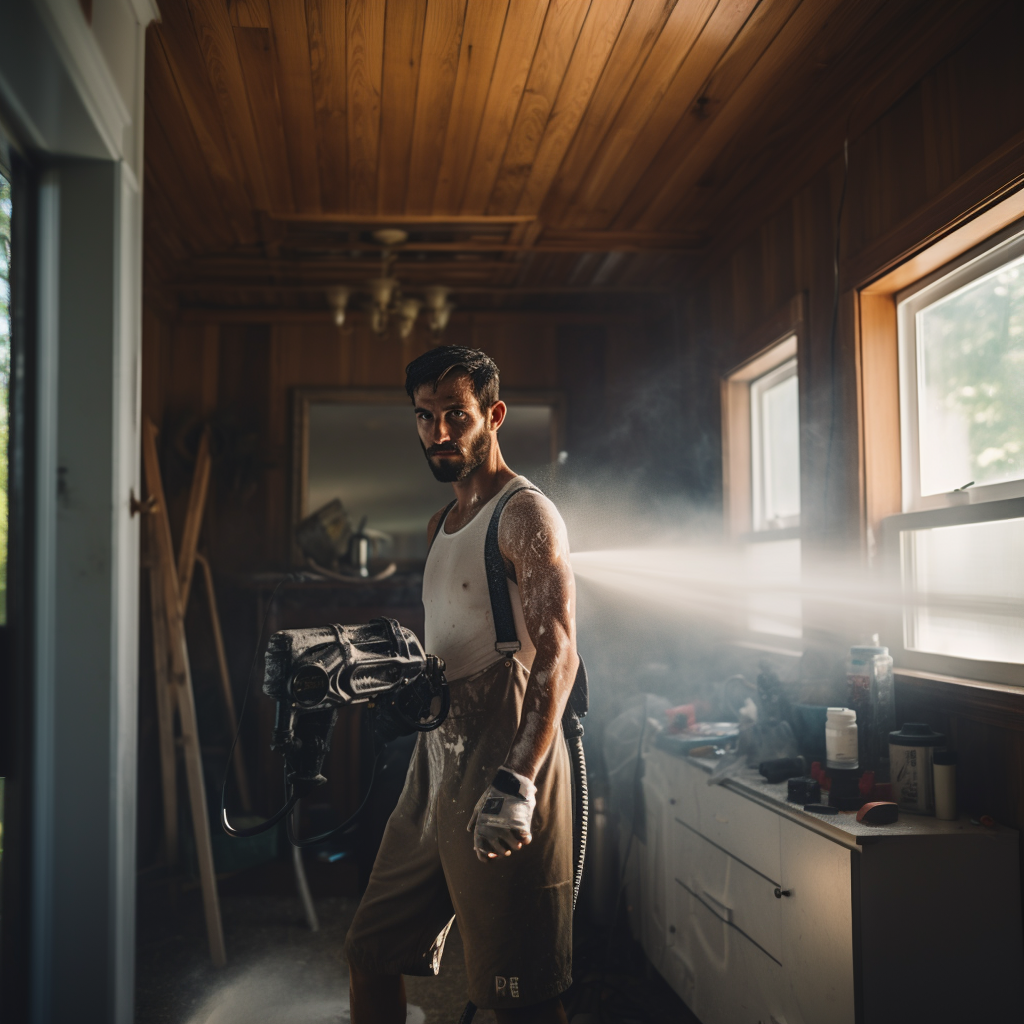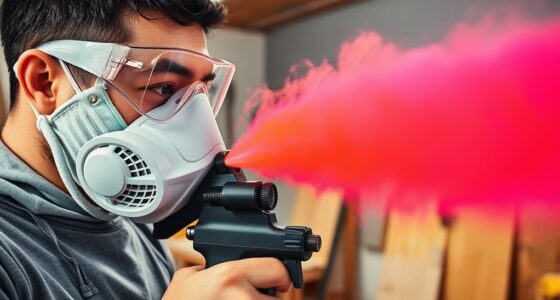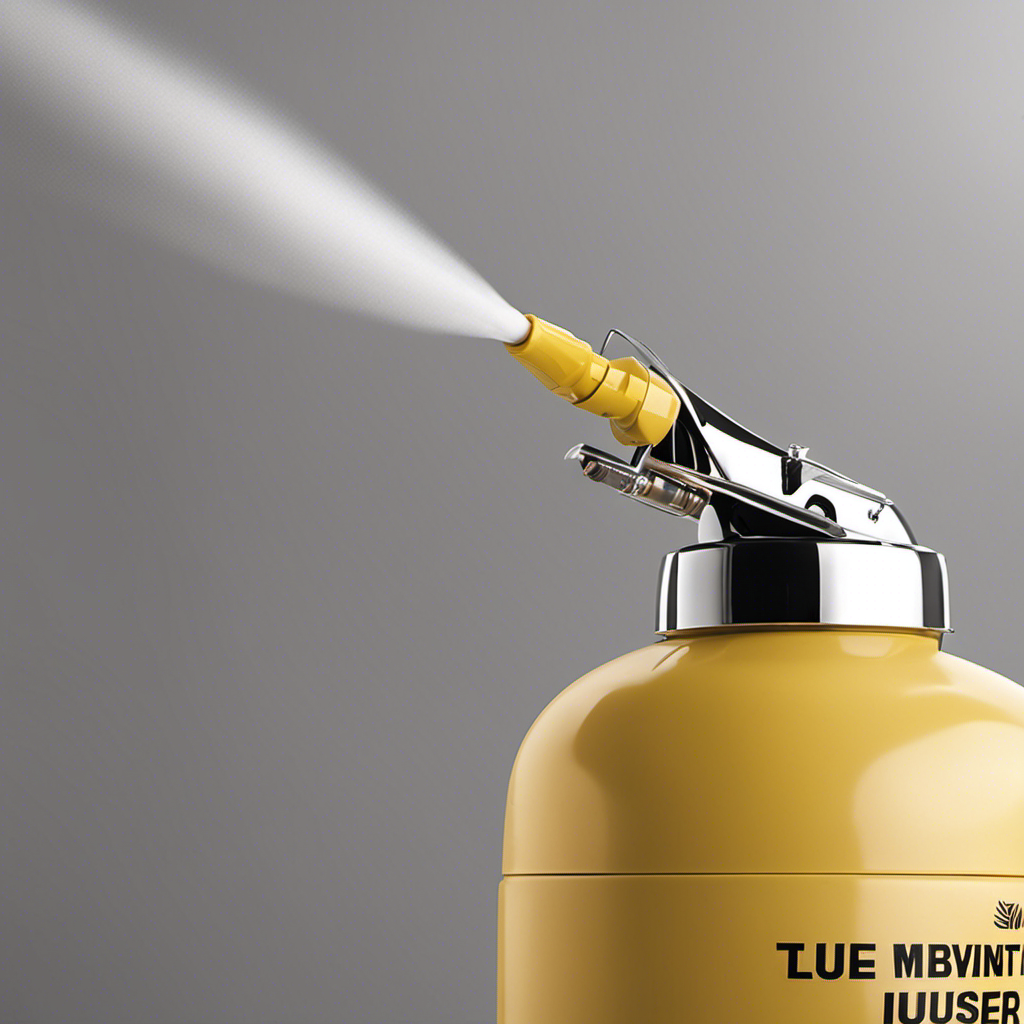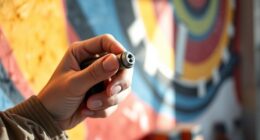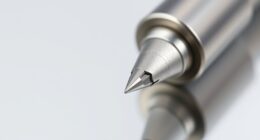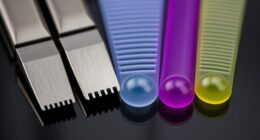Paint sprayers can be quite messy if you don’t use the right techniques or take precautions. Overspray often drifts onto nearby surfaces, creating extra cleanup and waste. To keep things neat, you need to cover furniture, use masking tape, and maintain proper spraying distance. Good ventilation and equipment control are essential, too. Want to learn how to manage overspray effectively and get a professional finish? Keep going for essential tips and tricks.
Key Takeaways
- Paint sprayers can create overspray that drifts beyond surfaces, making cleanup necessary.
- Proper workspace setup with coverings and masking reduces mess during spraying.
- Using equipment with advanced control features minimizes overspray and maintains cleaner results.
- Adequate ventilation and airflow help disperse fumes and overspray effectively.
- Correct techniques and regular equipment maintenance are essential to prevent excessive mess and overspray.
Understanding Overspray and Its Impact
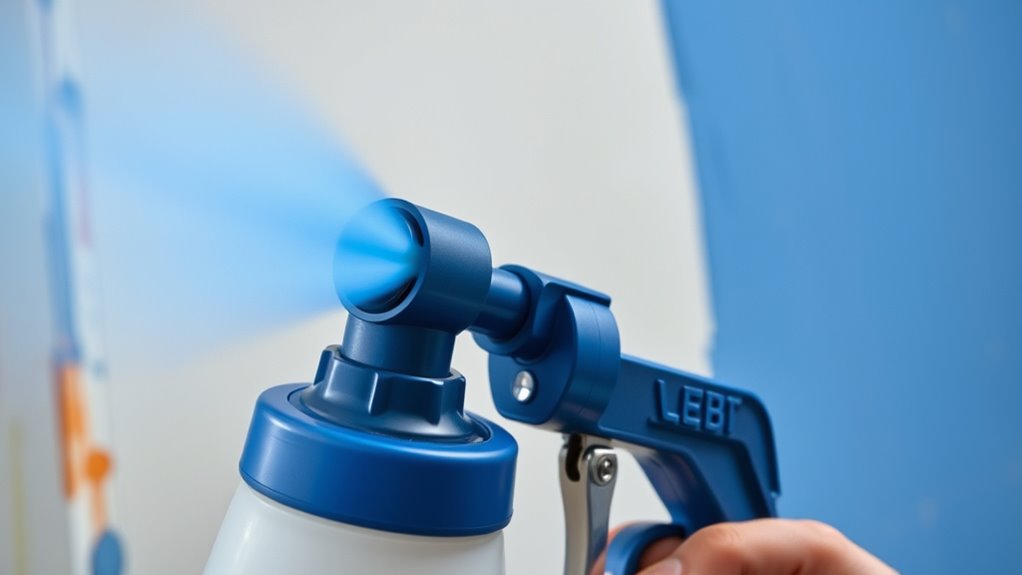
Overspray occurs when paint particles drift beyond the intended surface, often creating a mess and wasting material. This is caused by factors like paint splatter and aerosol drift, which happen during spraying. Paint splatter results when small droplets escape the spray pattern and land elsewhere, leaving unwanted marks on nearby surfaces. Aerosol drift refers to fine particles carried away by air currents, spreading paint beyond your target area. Both issues increase cleanup time and can damage furniture, flooring, or other items close by. Understanding how overspray behaves helps you control it better. It’s not just about wasting paint; it’s about maintaining a clean workspace and achieving a professional finish. Recognizing these sources of overspray sets the foundation for better spraying techniques and protective measures. Additionally, employing proper technique and equipment can significantly reduce overspray and improve overall results. Modern spray guns and nozzles designed with advanced technology help deliver more precise applications and minimize excess paint dispersion, leading to cleaner workspaces and better finishes. Incorporating paint viscosity control can also enhance spray accuracy and reduce unintended spray spread, further improving your results. Implementing professional-grade filters in your spray setup can trap overspray particles, further reducing mess during use. Recent innovations in Nike Tech materials also contribute to more precise application and reduced mess during use.
Choosing the Right Paint Sprayer for Your Project
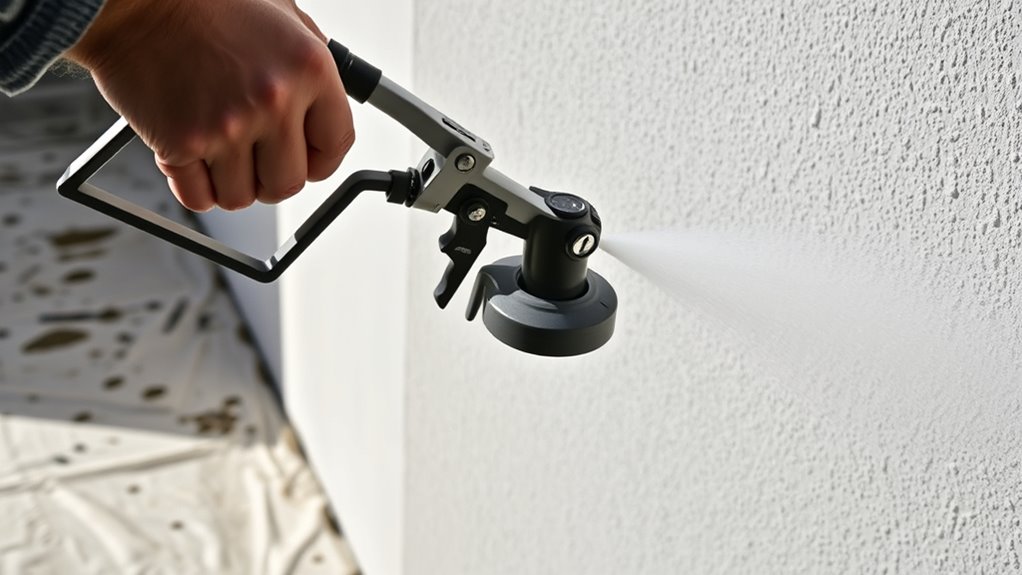
Choosing the right paint sprayer can make a significant difference in managing overspray and achieving a clean, professional finish. When selecting a sprayer, consider the paint thickness you’ll be working with—some models handle thicker paints better, reducing drips and overspray. If your project involves precise color matching, opt for a sprayer known for fine, consistent spray patterns to ensure accurate mixing and application. For small or detailed work, a smaller, HVLP sprayer offers better control and less mess. Larger projects may require airless sprayers for speed but may increase overspray risk. Matching your sprayer to the project size, paint type, and desired finish helps minimize mess and ensures efficient, quality results. Careful selection prevents frustration and improves your overall painting experience. Sound healing science principles can also inform your choice of equipment for optimal results. Additionally, understanding spray pattern control can help you reduce overspray and achieve a more professional look. Incorporating powerful persuasive words into your instructions can also enhance your communication with clients or team members about proper equipment use. Being aware of interior painting techniques can further help you refine your skills and reduce overspray during application. To further improve your results, consider exploring equipment with advanced technology features that enhance spray precision and control.
Preparing Your Workspace to Minimize Mess
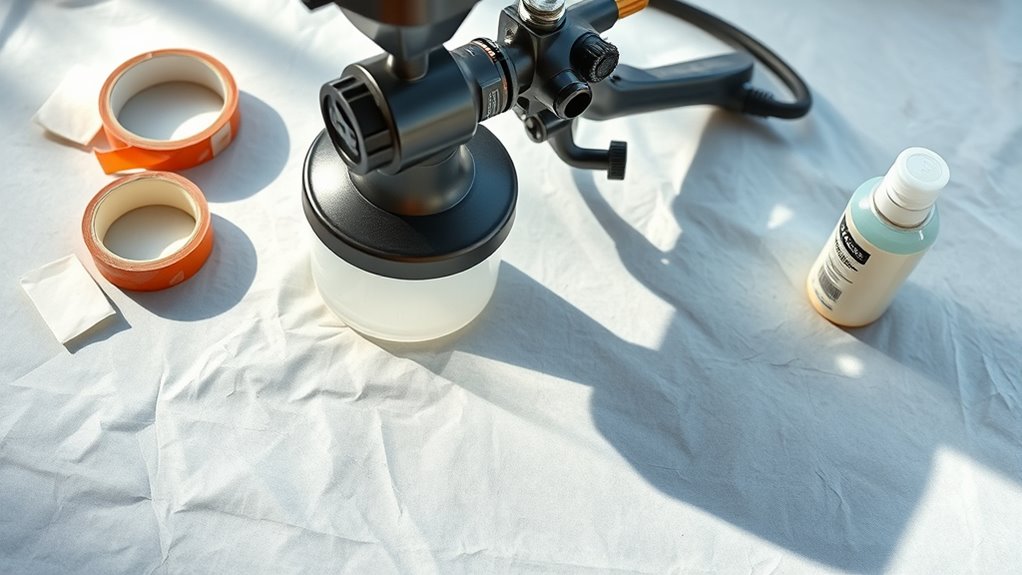
Before you start spraying, cover nearby furniture and floors to catch drips. Clear your work surface of unnecessary items to keep everything organized and accessible. Make sure the area is well-ventilated to reduce fumes and improve airflow during the project. Additionally, consider using protective gear such as masks and goggles to ensure safety from overspray and fumes. Proper workspace setup can further help contain overspray and make cleanup easier. Ensuring proper air quality during painting can also contribute to a healthier environment and better results. Utilizing appropriate cookie categories like necessary and functional cookies can improve your browsing experience while managing your privacy preferences effectively.
Cover Surrounding Areas
Have you prepared your workspace to keep the mess contained? Covering surrounding areas is key to managing overspray and keeping your space clean. Start by masking off walls, trim, and furniture with painter’s tape and plastic sheeting. Use drop cloths or old sheets to cover floors and large surfaces. Adjust your spray distance to avoid unnecessary overspray, especially around delicate items. Keep the paint nozzle clean and check your spray pattern regularly to prevent drips. Consider blocking vents or openings that could let paint drift into unwanted areas. Properly covering and protecting surfaces minimizes cleanup time and keeps your project neat. Planning ahead ensures your workspace stays organized, reducing the mess and making your painting experience smoother. Additionally, understanding water-based paints can help you choose the right products for easier cleanup and less overspray. Using the appropriate equipment maintenance techniques also extends the lifespan of your sprayer and maintains a consistent spray pattern. Regularly inspecting your equipment can prevent overspray issues, saving you time and effort during cleanup. Being aware of spill management strategies can further help contain accidental splashes and drips, ensuring a cleaner work environment. Moreover, incorporating ventilation control into your setup can significantly reduce the spread of overspray and improve overall safety during painting.
Clear Work Surface
Once you’ve covered the surrounding areas to contain overspray, it’s time to focus on clearing your work surface. Start by organizing your tools and supplies, keeping everything you need within easy reach to avoid unnecessary movement. Clear the surface of any clutter or objects that could get in the way or be damaged by paint. Ensuring your equipment is properly calibrated before starting helps prevent uneven spray and reduces mess. Proper surface organization minimizes accidental spills and overspray, making cleanup easier. Keep paint containers, brushes, and rags neatly arranged so you can work efficiently. A tidy, well-prepared workspace not only reduces mess but also helps you maintain control over your project, resulting in a cleaner, more professional finish. Being aware of best practices for managing overspray can further enhance your painting results, especially when understanding how to control narcissistic behaviors that could disrupt your focus. Additionally, maintaining a clean work area can prevent dust and debris from settling on wet paint, ensuring a smoother finish. Using essential oils for respiratory health can help create a more comfortable environment if fumes become overwhelming.
Ventilate Properly
Why is proper ventilation essential when preparing your workspace for painting? Good airflow helps remove fumes, reduces odors, and prevents overspray from settling. It also improves air filtration, keeping airborne particles in check. To ensure effective ventilation, consider these steps:
- Open windows and doors to create cross-ventilation
- Use exhaust fans to pull out fumes and overspray
- Incorporate air purifiers with HEPA filters for better air filtration
- Wear a mask to protect yourself from airborne particles
- Control odors with activated charcoal or odor-absorbing filters
- Utilizing AI-driven security systems can help monitor and alert you to any safety hazards in your workspace.
- Ensuring proper air circulation can significantly reduce the buildup of overspray and improve overall workspace cleanliness.
Proper ventilation minimizes mess by dispersing overspray and fumes quickly. It also creates a safer environment, so your workspace stays cleaner and more comfortable during and after painting.
Techniques for Controlling Overspray Effectively
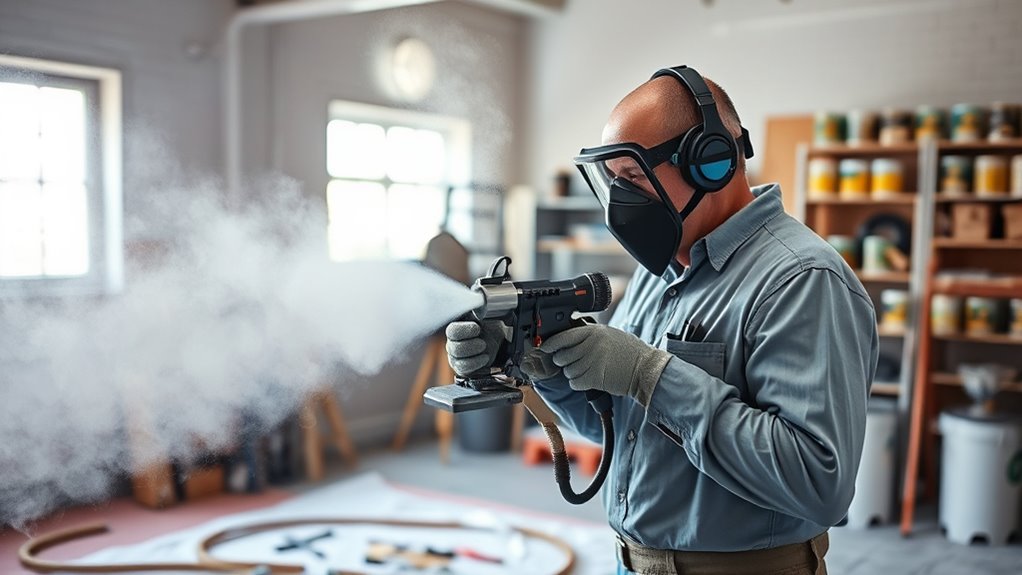
Controlling overspray is vital for achieving clean, professional results with paint sprayers. To do this effectively, you need to manage air flow carefully. Adjust the spray gun’s air cap to direct a steady, consistent stream of air, which helps minimize mist and drift. Additionally, controlling paint viscosity plays a key role; thinning the paint properly ensures a smoother spray and reduces the likelihood of overspray. Always follow the manufacturer’s recommended thinning ratios. Keep your spray pattern even by maintaining a consistent distance from the surface—about 6-12 inches—and use overlapping strokes. Moving at a steady pace helps prevent excessive buildup and overspray. Combining proper air flow adjustments with ideal paint viscosity results in cleaner, more controlled spraying.
Protective Gear and Coverings to Keep Your Area Clean
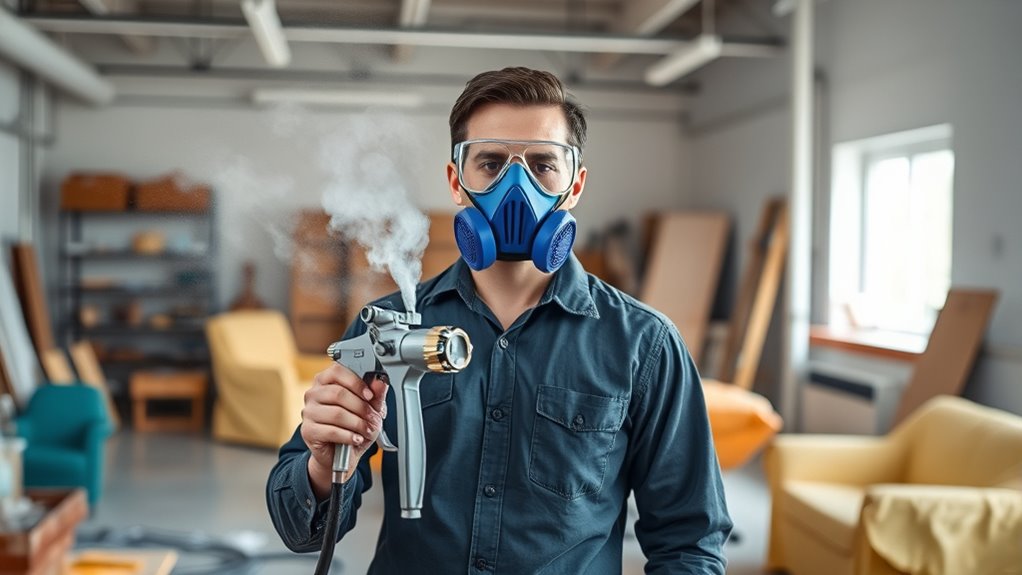
Using protective gear and coverings is your best defense against the mess that paint sprayers can create. Proper coverings protect surfaces and prevent overspray from settling where it shouldn’t. Wear a respirator mask to guard against inhaling fumes, and goggles to shield your eyes from paint splatters. Use drop cloths or plastic sheets to cover floors and furniture, ensuring paint consistency stays controlled and doesn’t spread. Consider masking tape for edges and trim to maintain clean lines. When adjusting brush techniques, keep movements deliberate to reduce unnecessary overspray. Cover vents and electrical outlets to avoid paint infiltration. These precautions keep your workspace clean and make cleanup easier, regardless of your experience level with paint sprayers.
Cleaning and Maintaining Your Paint Sprayer
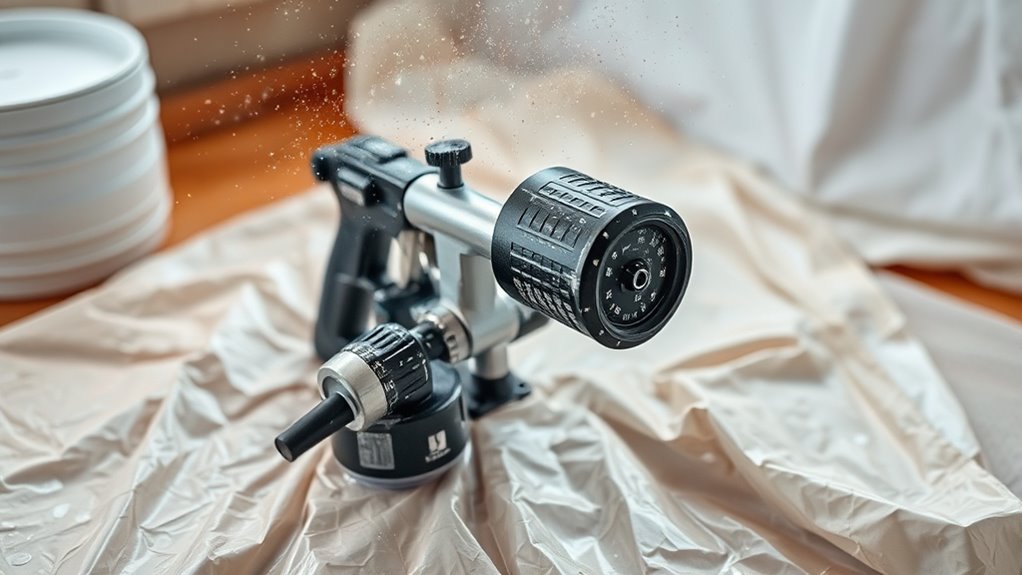
Proper cleaning and maintenance are vital to keep your paint sprayer functioning smoothly and prolong its lifespan. After each use, clean all components thoroughly to prevent paint buildup and guarantee consistent spray patterns. Proper paint storage is also essential; store your sprayer in a dry, clean place to avoid corrosion and damage. Regularly check and calibrate your equipment to maintain ideal performance and spray accuracy. This includes inspecting seals, filters, and nozzles, replacing worn parts as needed. Maintaining your sprayer prevents clogs and uneven application, saving you time and effort on future projects. By dedicating a few minutes to cleaning and calibration, you’ll keep your equipment in top condition, ensuring smooth operation and professional results every time.
Common Mistakes That Lead to Excessive Overspray
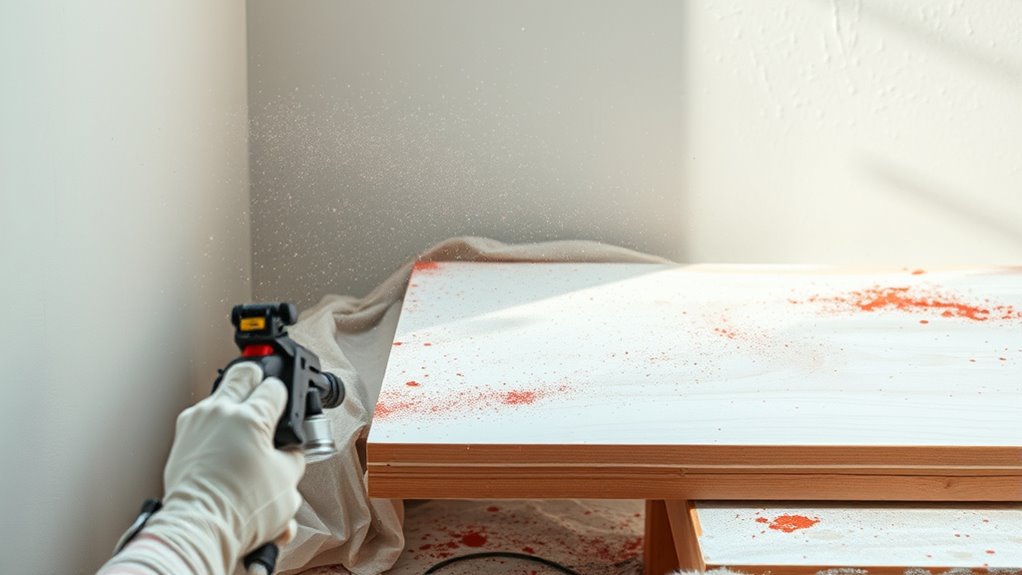
One major cause of excessive overspray is using incorrect spray techniques that spread paint unevenly. Setting your nozzle improperly can also lead to more paint outside your target area. Additionally, skipping surface preparation makes it harder to control the spray and increases mess.
Incorrect Spray Technique
Incorrect spray technique is a common culprit behind excessive overspray when using paint sprayers. You might be rushing your brush techniques or not adjusting for paint viscosity, which causes uneven spray patterns. Holding the sprayer too close or moving too quickly spreads paint unevenly, increasing mess. Failing to maintain a consistent distance results in overspray and drips. Additionally, ignoring paint viscosity can lead to a too-thin or too-thick coating, affecting spray quality. Poor technique, like jerky motions or inconsistent speed, worsens overspray and uneven coverage. To improve, focus on steady, overlapping passes, maintain proper distance, and adjust your technique based on the paint’s consistency. This careful approach minimizes mess and ensures a smooth, even finish.
Wrong Nozzle Settings
Choosing the wrong nozzle setting is a quick way to create a mess with your paint sprayer. If your nozzle calibration isn’t correct, your spray pattern can become uneven or overly broad, leading to excessive overspray. When the spray pattern is too wide, you’ll waste paint and create drips or splatters outside your target area. Conversely, a narrow pattern might cause uneven coverage, prompting you to go over spots multiple times, increasing messiness. Always check and adjust your nozzle to match your project’s needs. Proper nozzle calibration guarantees you get a consistent spray pattern, reducing overspray and controlling paint flow. Taking a moment to set your nozzle correctly helps you work more efficiently and keeps your workspace cleaner.
Neglecting Surface Preparation
Neglecting proper surface preparation often leads to excessive overspray because the paint struggles to adhere smoothly, causing it to bounce off or spray unevenly. When you skip cleaning, sanding, or repairing surface damage, the paint’s adhesion weakens, increasing the likelihood of overspray and drips. Poorly prepared surfaces create inconsistent spray patterns, wasting paint and making cleanup messier. To avoid this, confirm you:
- Clean the surface thoroughly to remove dirt and oils
- Sand rough or glossy areas for better paint adhesion
- Repair surface damage like holes or cracks
- Remove old peeling paint before spraying
- Mask off areas that don’t need paint
Proper preparation creates a smooth, clean surface that promotes better paint adhesion and reduces overspray, making your project neater and more efficient.
Tips for Achieving a Professional Finish With Less Mess

To achieve a professional finish with less mess when using paint sprayers, preparation is key. Start by mastering proper brush techniques to handle edges and tricky spots, reducing the need for touch-up work later. Keep your paint at the right consistency—neither too thick nor too thin—to ensure smooth, even coverage and minimize overspray. Practice on a scrap surface first to fine-tune your spray distance and angle, which helps control overspray and drips. Use masking tape and drop cloths diligently to protect surrounding areas. Consistent, controlled movements will give you a cleaner finish and reduce mess. By focusing on these tips, you’ll streamline your process, achieve a professional look, and keep overspray to a minimum.
Frequently Asked Questions
How Does Weather Affect Overspray Control During Outdoor Painting?
Weather markedly impacts overspray control during outdoor painting. Wind drift can cause your paint to blow off course, making overspray harder to manage. Humidity effects also play a role; high humidity can slow drying, increasing the chance of overspray spreading or settling unevenly. To minimize mess, check the weather forecast, avoid painting on windy days, and choose times with lower humidity for better control and a cleaner finish.
Can I Use Painter’S Tape to Reduce Overspray on Delicate Surfaces?
Yes, you can use painter’s tape to reduce overspray on delicate surfaces. Proper masking techniques, including applying painter’s tape carefully and using surface preparation, helps protect areas from paint. Make sure the surface is clean and dry before taping, and press down edges to prevent paint seepage. This approach keeps your work neat, minimizes mess, and guarantees precision on sensitive surfaces.
What Are the Best Storage Practices for Paint Sprayers to Prevent Mess?
To prevent messes, you should follow key storage tips for your paint sprayer. Always clean your equipment thoroughly after each use, removing any leftover paint and wiping down surfaces. Store it in a dry, protected area to avoid damage and leaks. Proper storage helps with equipment maintenance, extending its lifespan and ensuring it’s ready for your next project. Keep hoses and nozzles organized and secure to prevent accidental spills or damage.
How Do I Dispose of Leftover Paint and Overspray Safely?
You might worry about the mess leftover paint and overspray can create, but proper disposal makes it simple. For paint disposal, always follow local regulations—use designated containers for leftover paint and never pour it down drains. When it comes to overspray cleanup, wear protective gear and wipe surfaces with appropriate cleaners. This approach keeps your workspace safe and environmentally friendly, ensuring you handle leftover paint and overspray responsibly.
Are There Eco-Friendly Options to Minimize Overspray and Environmental Impact?
You can reduce overspray and environmental impact by choosing eco-friendly coatings and biodegradable sprayers. These options help minimize harmful emissions and waste, making your project greener. Using eco-friendly coatings guarantees fewer toxic chemicals are released, while biodegradable sprayers break down naturally, reducing landfill waste. By selecting these environmentally conscious tools, you make your painting process cleaner and more sustainable, benefiting both your space and the planet.
Conclusion
With the right tools, preparation, and techniques, you can tame overspray and keep your workspace tidy. Think of controlling overspray as steering a ship—steady hands and a clear plan prevent chaos from taking over. By choosing the proper sprayer, wearing protective gear, and practicing mindful spraying, you’ll turn a potentially messy task into a smooth sailing project. Remember, a little effort goes a long way in transforming paint splatters from chaos into craftsmanship.
Franz came aboard the Paint Sprayer Zone team with a background in both journalism and home renovation. His articulate writing style, combined with a passion for DIY projects, makes him an invaluable asset. Franz has a knack for breaking down technical jargon into easy-to-understand content, ensuring that even the most novice of readers can grasp the complexities of paint sprayers.
